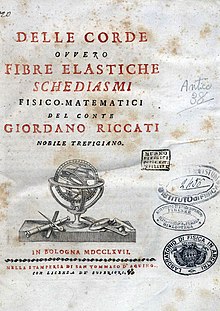| Giordano Riccati | |
|---|---|
 Giordano Riccati Giordano Riccati | |
| Born | 25 February 1709 Castelfranco Veneto, Republic of Venice |
| Died | 20 July 1790 Treviso, Republic of Venice |
| Alma mater |
|
| Occupation | Mathematician and physicist |
| Parent(s) | |
| Family | Vincenzo Riccati, Francesco Riccati |
Giordano Riccati or Jordan Riccati (25 February, 1709 – 20 July, 1790) was an Italian mathematician and physicist.
Biography
Giordano Riccati was born in 1709 in Castelfranco Veneto, a small town about 30 km north of Padua. He was the brother of Vincenzo Riccati and the fifth son of the theoretical mechanician Jacopo Riccati. He began his studies at the College of St. Francis Xavier in Bologna, under the guidance of Francesco Saverio Quadrio and Luigi Marchenti, a pupil of the French mathematician Pierre Varignon. In 1727, he returned to Castelfranco, where his father taught him geometry, trigonometry, calculus, statics and dynamics. He then moved to the University of Padua and attended Giovanni Poleni's lessons on hydraulics as well as the lectures of the famous physician and naturalist Antonio Vallisneri. He studied literature, philosophy, theology, architecture, acoustics and music theory. He made significant contributions in the field of physics and mathematics applied to music, publishing the Saggio sulle leggi del contrappunto , which tried to prove that music is not just an art, but it is a science as well, a Trattato delle corde, ovvero delle Fibre Elastiche , and some studies on the works of Tartini and Rameau. Giordano helped with the improvements to the Cathedral of Treviso. He died Treviso on July 20, 1790.
Riccati was a member of the Accademia Galileiana of Padua, of the Academy of Sciences of the Institute of Bologna and of the Italian National Academy of Sciences.
Contributions
Riccati was the first experimental mechanician to study material elastic moduli as we understand them today. His 1782 paper on determining the relative Young's moduli of steel and brass using flexural vibrations preceded Thomas Young's 1807 paper on the subject of moduli. The ratio that Riccati found was:
Even though the experiments were performed more than 200 years ago, this value is remarkably close to accepted values found in engineering handbooks in 2007.
References
- G. Riccati, 1782, Delle vibrazioni sonore dei cilindri, Mem. mat. fis. soc. Italiana, vol. 1, pp 444-525.
- Truesdell, Clifford A., 1960, The Rational Mechanics of Flexible or Elastic Bodies, 1638-1788: Introduction to Leonhardi Euleri Opera Omnia, vol. X and XI, Seriei Secundae. Orell Fussli.
- Bell, J. F., 1971, The experimental foundations of solid mechanics, Handbuch der Physik VIa/I, Springer-Verlag, Berlin.
Works

- Saggio sopra le leggi del contrappunto (in Italian). Castelfranco: Giulio Trento. 1762.
- Delle corde (in Italian). Bologna: Stamperia di S. Tommaso d'Aquino. 1767.
External links
- O'Connor, John J.; Robertson, Edmund F., "Giordano Riccati", MacTutor History of Mathematics Archive, University of St Andrews
- Roero, Clara Silvia (2016). "Riccati, Giordano". Dizionario Biografico degli Italiani, Volume 87: Renzi–Robortello (in Italian). Rome: Istituto dell'Enciclopedia Italiana. ISBN 978-8-81200032-6.
